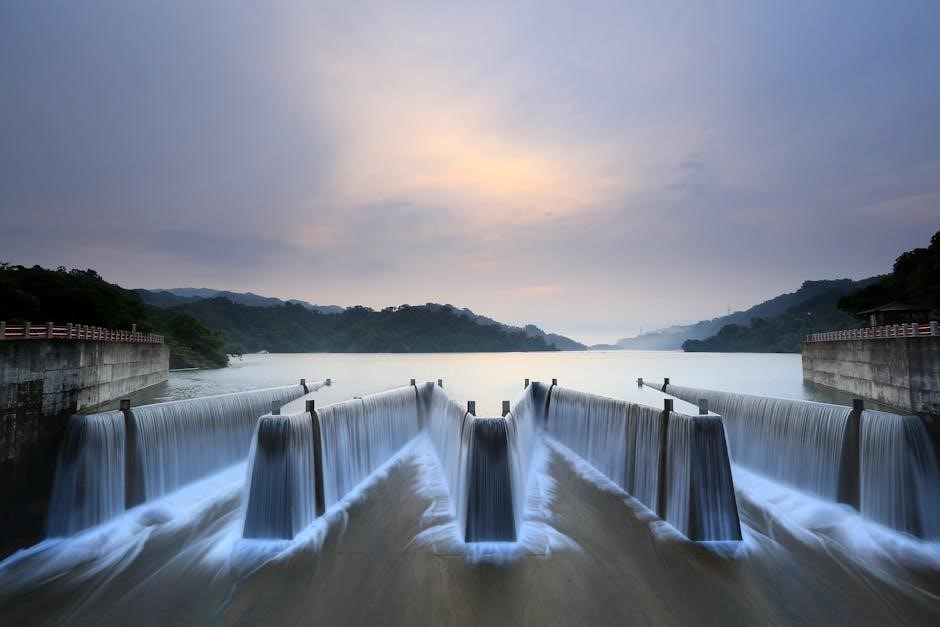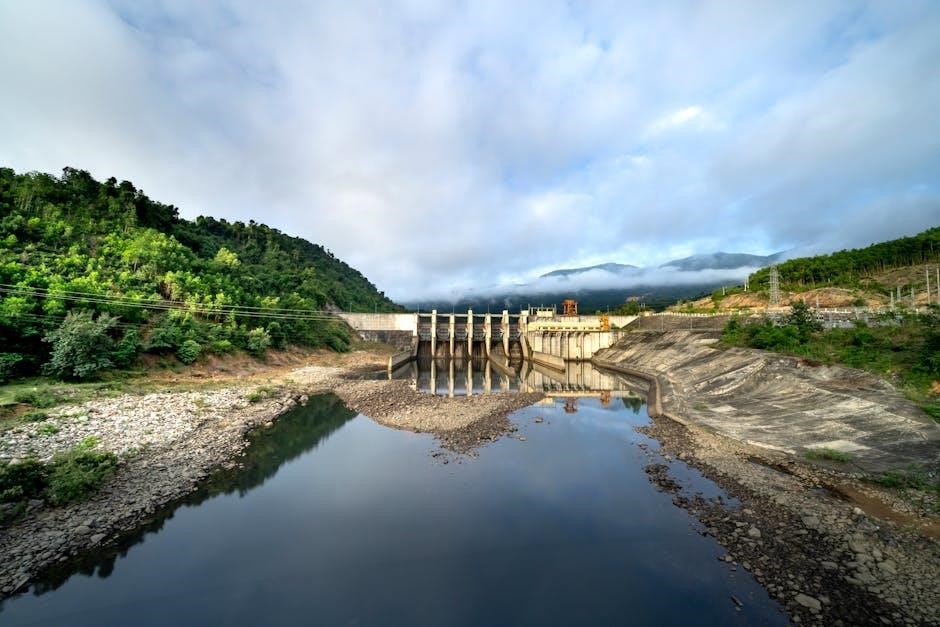Energy flow in ecosystems is the unidirectional transfer of energy from one organism to another, governed by the laws of thermodynamics. It originates from the Sun, powering biological processes and nutrient cycling within ecosystems.
1.1 Definition of Energy Flow
Energy flow refers to the unidirectional transfer of energy through an ecosystem, beginning with producers who capture solar energy and passing it to consumers. This process is fundamental to ecosystem functioning, as it sustains life and drives biological processes. Energy flow is typically represented by food chains or webs, illustrating how energy moves from one trophic level to the next. The Sun is the primary energy source, and only a small fraction of solar energy is harnessed by ecosystems. Energy transfer between trophic levels is inefficient, with approximately 10% of energy passing to the next level, making energy flow a critical ecological concept.
1.2 Importance of Energy Flow in Ecosystems
Energy flow is crucial for maintaining ecosystem balance and supporting life. It drives nutrient cycling, powers biological processes, and sustains the structure of food webs. By understanding energy flow, ecologists can assess ecosystem health, predict population dynamics, and manage resources effectively. Energy flow also highlights the interdependence of organisms, showing how each species relies on others for survival. This fundamental process ensures that ecosystems function efficiently, allowing for the continuous transfer of energy from producers to decomposers. Without energy flow, ecosystems would collapse, making it essential for studying ecological dynamics and conservation strategies focused on sustainability and biodiversity preservation.

Key Concepts of Energy Flow
Energy flow in ecosystems is unidirectional, following the laws of thermodynamics, and involves trophic levels, food chains, and food webs that model energy transfer between organisms.
2.1 Laws of Thermodynamics and Energy Flow
The laws of thermodynamics govern energy flow in ecosystems. The first law states that energy is conserved but changes form, while the second law introduces entropy, explaining energy loss as it flows through systems. In ecosystems, energy transfer between trophic levels is inefficient, with only about 10% of energy passing to the next level. This inefficiency arises from metabolic processes, growth, and reproduction, ensuring energy flow is unidirectional. These principles shape the structure and function of ecosystems, limiting food chain length and emphasizing the Sun’s role as the primary energy source.
2;2 Trophic Levels and Their Role in Energy Transfer
Trophic levels represent the feeding positions of organisms in an ecosystem, forming a hierarchy that directs energy flow. Producers, such as plants, occupy the first trophic level, converting solar energy into biomass. Herbivores form the second level, acquiring energy by consuming producers, while carnivores and higher predators follow. Each level transfers energy through consumption, with inefficiencies causing only 10% of energy to pass to the next level. Decomposers, though not part of the primary food chain, recycle nutrients back to producers. This hierarchical structure ensures energy flows upward, supporting ecosystem functioning and maintaining the balance of biological processes.
2.3 Food Chains and Food Webs as Models of Energy Flow
Food chains and food webs are fundamental models illustrating energy flow through ecosystems. A food chain is a linear sequence of organisms, showing how energy moves from producers to consumers. For example, grass → rabbit → fox. Food webs, however, depict multiple interconnected food chains, revealing diverse energy pathways. Both models highlight the unidirectional flow of energy and the inefficiency of transfer between trophic levels. They provide a visual representation of ecosystem dynamics, emphasizing how energy is distributed and utilized. These models are essential tools for understanding the complex interactions within ecosystems and the critical role of energy flow in sustaining life.
Mechanisms of Energy Flow in Ecosystems
Energy flows through ecosystems via producers, consumers, and decomposers. Producers capture solar energy, consumers transfer energy by eating other organisms, and decomposers recycle nutrients back into the ecosystem.
3.1 Producers and Primary Production
Producers, primarily plants, algae, and some bacteria, are the foundation of energy flow in ecosystems. They capture solar energy through photosynthesis, converting it into stored chemical energy. This process, called primary production, forms the base of the food chain. Gross primary production (GPP) is the total energy captured, while net primary production (NPP) is the energy remaining after cellular respiration. NPP is the energy available to consumers and drives ecosystem functioning. Producers also include autotrophic organisms that harness chemical energy in ecosystems without sunlight, ensuring energy flow begins at their level. Their role is critical for sustaining life and energy transfer in ecosystems.
3.2 Consumers and Energy Transfer Between Trophic Levels
Consumers are organisms that obtain energy by feeding on other organisms or organic matter. They play a crucial role in energy transfer between trophic levels, with energy flowing upward from producers to herbivores and carnivores. However, energy transfer is inefficient, as only 10% of energy is typically passed to the next trophic level. This inefficiency is due to metabolic processes, heat loss, and excretion. Ecological efficiency, the percentage of energy transferred, varies but remains low. Consumers also influence ecosystem dynamics by regulating prey populations and maintaining biodiversity. Despite inefficiencies, consumers are essential for the functioning and stability of ecosystems, ensuring energy flow continues through the food chain.
3.3 Decomposers and Their Role in Energy Cycling
Decomposers, such as bacteria and fungi, are vital for energy cycling in ecosystems. They break down dead organisms and organic matter, releasing nutrients back into the environment. This process recycles energy stored in biomass, returning it to the ecosystem for reuse by producers. Decomposers facilitate nutrient cycling, enabling the continuous flow of energy through the ecosystem. They also contribute to energy loss by converting some energy into heat, which dissipates and is no longer available for biological processes. Decomposers ensure the sustainability of ecosystems by maintaining nutrient availability and energy flow, linking producers and consumers in the energy cycle. This process is essential for ecosystem health and stability.

Ecological Models of Energy Flow
Ecological models, like energy pyramids and Y-shaped diagrams, illustrate energy flow through ecosystems. They depict energy distribution across trophic levels and pathways, such as grazing and detritus food chains.
4.1 Energy Pyramids and Their Types

Energy pyramids are visual representations of energy flow through ecosystems, showing the distribution of energy at each trophic level. There are three types: the pyramid of energy, pyramid of biomass, and pyramid of numbers. The energy pyramid illustrates the flow of energy, with each level representing a smaller amount of energy available than the one below it. This reflects the inefficiency of energy transfer, as only about 10% of energy is passed to the next trophic level. The biomass pyramid shows the mass of organisms at each level, while the numbers pyramid represents the count of individuals. These models help in understanding the structure and function of ecosystems.
4.2 Y-Shaped Energy Flow Model in Ecosystems
The Y-shaped energy flow model represents the dual pathways of energy transfer in ecosystems, combining both grazing and detritus food chains. In this model, energy flows from producers to herbivores (grazing pathway) and to decomposers (detritus pathway), forming a Y shape. This model illustrates how energy is partitioned between consumers and decomposers, showcasing the interconnectedness of trophic levels. It highlights the efficiency of ecosystems in utilizing energy, as both pathways contribute to the overall energy dynamics. This model provides a comprehensive view of energy flow, emphasizing the role of decomposers in nutrient recycling and the unidirectional nature of energy transfer.

Factors Affecting Energy Flow in Ecosystems
Biological factors, such as trophic interactions, and environmental factors, like climate change and human activities, significantly influence energy flow efficiency and ecosystem stability.
5.1 Biological Factors Influencing Energy Transfer
Biological factors, such as predator-prey relationships, competition, and species diversity, significantly impact energy transfer efficiency. Predation can redirect energy flows, while competition alters resource availability. Decomposers play a crucial role in recycling nutrients, enhancing energy cycling. Additionally, the structure of food webs and the presence of keystone species influence how energy is distributed across trophic levels. These interactions determine the overall resilience and productivity of ecosystems, shaping the flow of energy from producers to consumers and decomposers.
5.2 Environmental Factors Impacting Energy Flow
Environmental factors such as temperature, precipitation, and light exposure significantly influence energy flow in ecosystems; These factors affect photosynthesis rates, altering the energy available to producers, which in turn impacts consumers. Seasonal changes can disrupt energy transfer by modifying the availability of resources and altering trophic interactions. Additionally, human-induced environmental changes, such as pollution and climate change, can disrupt energy dynamics by affecting species survival and nutrient cycling. Extreme weather events and habitat destruction further exacerbate these disruptions, leading to imbalances in energy flow and potentially altering ecosystem stability and biodiversity.

Energy Efficiency in Ecosystems
Energy efficiency in ecosystems refers to the percentage of energy transferred between trophic levels, typically around 10%. Losses occur due to heat and metabolic processes, governed by thermodynamic laws.
6.1 Ecological Efficiency and Its Significance
Ecological efficiency is the percentage of energy transferred from one trophic level to the next. It is crucial as it determines the stability and productivity of ecosystems. Typically, only 10% of energy is transferred, with the rest lost as heat or through metabolic processes. This inefficiency explains why ecosystems require constant energy input to sustain complex food webs. Higher efficiency at lower trophic levels supports biodiversity and ensures the survival of higher-level consumers. Understanding ecological efficiency aids in managing ecosystems and predicting how environmental changes may impact energy dynamics and species populations. It is a fundamental concept in ecology, shaping ecosystem structure and function.
6.2 Limitations of Energy Transfer Between Trophic Levels
Energy transfer between trophic levels is limited by inefficiencies inherent in biological processes. Only 10% of energy is typically transferred to the next level, as most is lost as heat or through metabolic activities. These losses are dictated by the second law of thermodynamics, which governs energy degradation. Additionally, not all consumed energy is assimilated, as some is excreted as waste. This inefficiency explains the hierarchical structure of ecosystems, with fewer apex predators than primary producers. Such limitations underscore the importance of continuous energy input to sustain ecosystem functioning and highlight the fragility of food webs in maintaining biodiversity and stability.

Role of Decomposers in Energy Cycling
Decomposers recycle nutrients from dead organisms, enabling energy reuse within ecosystems, thus sustaining productivity and energy balance.
7.1 Nutrient Recycling and Energy Flow
Decomposers play a crucial role in nutrient recycling, breaking down dead organic matter into inorganic substances like carbon dioxide, water, and minerals. These nutrients are then reused by producers, replenishing the ecosystem’s energy cycle. Energy from decomposed matter is released back into the environment, supporting primary production and sustaining the food web. This process ensures that energy and nutrients are continuously cycled, maintaining ecological balance and productivity. Decomposers, such as bacteria and fungi, are essential for this recycling, enabling the flow of energy to persist through trophic levels and supporting life within the ecosystem.

Human Impact on Energy Flow in Ecosystems
Human activities like deforestation, pollution, and overexploitation disrupt energy flow, reducing primary production and altering trophic structures. Climate change further impacts energy distribution and ecosystem balance.
8.1 Anthropogenic Factors Altering Energy Dynamics
Anthropogenic factors significantly alter energy dynamics in ecosystems. Deforestation disrupts primary production, reducing energy capture through photosynthesis. Pollution impairs aquatic ecosystems, affecting energy transfer efficiency. Overexploitation of resources depletes key species, destabilizing trophic structures. Climate change alters temperature and precipitation patterns, impacting metabolic rates and energy flow. Additionally, invasive species and habitat fragmentation disrupt native food webs, leading to inefficient energy redistribution. These human-induced changes cascade through ecosystems, diminishing biodiversity and resilience. Understanding these impacts is critical for mitigating ecological disruptions and preserving energy balance in natural systems. Such anthropogenic influences highlight the need for sustainable practices to maintain ecosystem health and functionality.
Energy flow is crucial for ecosystem balance, illustrating the Sun’s central role and inefficiencies in energy transfer, underscoring the importance of sustainable practices for ecological health.
9.1 Summary of Key Points on Energy Flow in Ecosystems
Energy flow in ecosystems is unidirectional, originating from the Sun and transferred through trophic levels via food chains and webs. Producers capture solar energy, converting it into biomass, while consumers acquire energy by feeding on other organisms. Decomposers recycle nutrients, ensuring energy cycling. The laws of thermodynamics dictate energy loss at each trophic level, with only 10% typically transferred. Ecological pyramids and models, like the Y-shaped energy flow diagram, illustrate these dynamics. Understanding energy flow is vital for managing ecosystems sustainably, as it reveals the interconnectedness of life and the importance of conservation practices to maintain ecological balance.




About the author